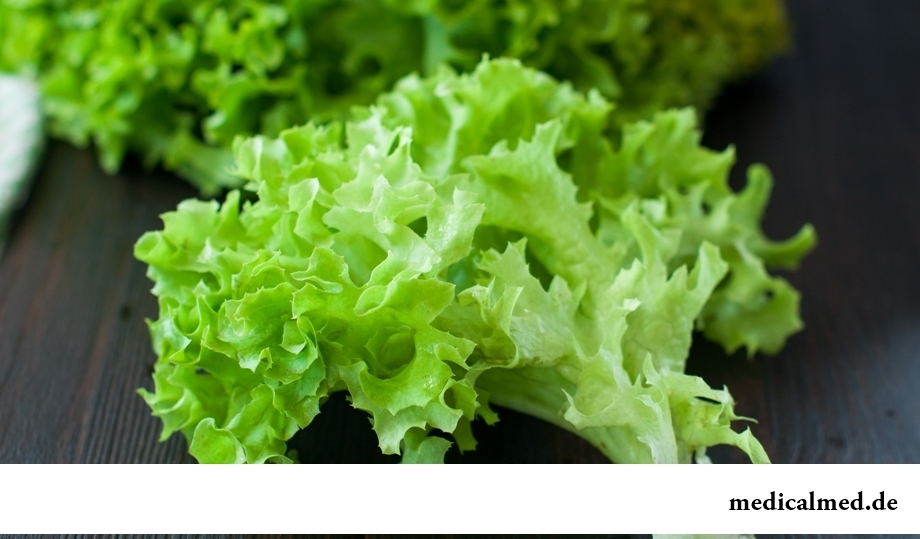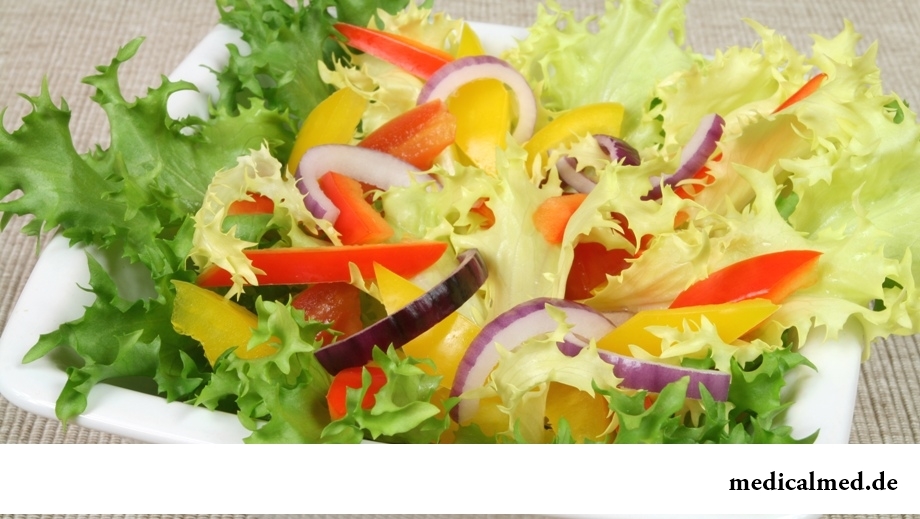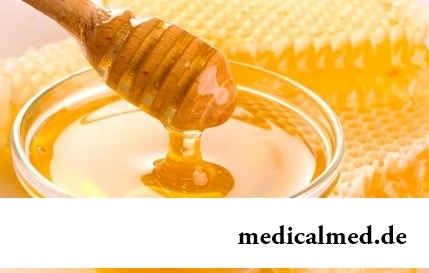





Lettuce
The lettuce not only is very useful and tasty sheet vegetable, but also serves as fine decoration of a holiday table.

Description of salad of lettuce
Lettuce – a plant from Astrov' family. The homeland of salad is authentically unknown. According to some data it is considered that an ancestor of a plant is wild salad which is eurysynusic in the countries of Asia, Europe, Africa and America now.
Several thousands of years cultivated a plant. It was actively eaten still by residents of Ancient Rome, Greece and Egypt. Today the lettuce is one of the most widespread garden vegetable cultures, and grow up it practically in all corners of our earth.
Salad has a set of grades which differ by the sizes, a form and coloring of leaves. The most widespread is the krupnokachanny grade, and the most tasty – the Italian grade of Radichye having a little bitterish taste. Also French grade of Batviya having a little juicy smack is widespread. In America the grade "Ice slope" having the crackling strong leaves enjoys the greatest popularity.
Use in cookery
The lettuce was widely adopted in cookery. It is used in the raw, adding to various vegetable salads, soups, sauces, snack, and also to fish and meat dishes. Well salad and heat treatment is exposed. It can be fried or extinguished, however it is necessary to consider that at the same time the lettuce loses the majority of useful properties.
Often lettuce uses just for decoration of dishes.
Salad needs to be used only fresh therefore it is better to use it right after purchase. If the turned yellow and sluggish leaves, and the line of a cut of a scape got a brownish shade from salad, salad stale means.
Besides, the cut-off lettuce leaves are not recommended to be held long in water, otherwise they lose the useful properties and vitamins. Fill salad just before giving on a table. If it too long lies in gas station, then it will settle and will take an unattractive form.
Structure and caloric content of salad of lettuce
In 100 g of salad of lettuce 95 g of water, 1,6 g of carbohydrates, 1,36 g of proteins, 1,3 g of cellulose, 0,6 g of ashes, 0,15 g of fats contain; vitamins: beta carotene (A), thiamin (B1), Riboflavinum (B2), Niacinum (B3), sincaline (B4), pantothenic acid (B5), pyridoxine (B6), folic acid (B9), ascorbic acid (C), tocopherol (E), phylloquinone (K); macrocells: phosphorus, sodium, magnesium, calcium, potassium; microelements: selenium, copper, manganese, iron, zinc.
Caloric content of salad of lettuce makes about 15 kcal on 100 g of a product.
Useful properties of salad of lettuce
Salad is a medical and dietary sheet vegetable. It is recommended to apply in dietary and a disk food, to include in a diet to people of old age and those who had a serious illness recently.
Lettuce leaves possess antibechic, expectorant, sedative and diuretic action. Useful properties of salad of lettuce apply at a diabetes mellitus, obesity, sleeplessness, atherosclerosis, tuberculosis, a hypertension, diseases of digestive, nervous and urinogenital systems.

The regular use of salad in food lowers the level of cholesterol in blood and helps to get rid of digestive tract diseases.
Salad juice in traditional medicine is used for removal of nervous irritability and disposal of sleeplessness, at liver diseases. And infusion of the crushed seeds of salad of lettuce helps nursing mothers to strengthen a lactation.
Contraindications
The lettuce is not recommended to be used at chronic and acute coloenterites and colitis, at an urolithiasis and gout.
Scientists from the Oxford university conducted a number of researches during which they came to a conclusion that vegetarianism can be harmful to a human brain as leads to decrease in its weight. Therefore scientists recommend not to exclude completely from the diet fish and meat.

What they, women? Beautiful, gentle, passionate and at the same time windy, gusty, and nervous. And what is stranger: all эт...
Section: Articles about health
The naturopathy sometimes moves as the new direction of medicine, something like fashionable hobby, and there is nothing farther from the truth. This most ancient direction, the word "naturopathy" is translated as "treatment by the nature", and, no doubt, treatment приро...
Section: Articles about health
All diseases from nerves – in this joke a big element of truth, are said by doctors. Constant stresses lead to decrease in protective forces of an organism, and it becomes vulnerable for a set of diseases. It is wrong to think that the stress is a problem of the present. Life of people and hundred, and one thousand years ago also abounded with problems therefore need of a relaxation understood in ancient times – to some techniques more than one thousand years. The person needs knowledge of how it is possible to relax, this knowledge пригод...
Section: Articles about health
Aspirin (acetylsalicylic acid) – one of those drugs which are known literally to all. It is available in each home first-aid kit...
Section: Articles about health
Weakness of an ankle joint – very widespread problem. Its existence is demonstrated by tendency to a podvorachivaniye of legs when walking on heels, frequent painful sprains, pain on average and anonymous toes even after small nagruzo...
Section: Articles about health
It is impossible to imagine human life in which there would be no plants. Practically in each apartment and any production room there are window plants, millions of people with pleasure are engaged in gardening and truck farming, many citizens spend free time on seasonal dachas. However we very seldom pay attention to those properties of our green pets who can make the neighbourhood with them unpleasant and even unsafe....
Section: Articles about health
Very often as a source of the infection which caused a disease serves our house - the place which a priori has to be safe. However...
Section: Articles about health
About 20% of the population of our planet have a hypertension (permanent increase in arterial pressure). This disease has an adverse effect on the standard of living, reduces working capacity, and in the absence of systematic treatment threatens with such complications as a heart attack...
Section: Articles about health
Stroke (acute disorder of cerebral circulation) – one of the most widespread neurologic diseases. Annually in the world more than 6 million people die of this illness. From the survived patients about 80% become disabled people, and nearly a third from them needs afterwards permanent care. In fact, the stroke creates a situation at which a part of cells of a brain loses blood access, loses an opportunity to receive oxygen and nutrients, and perishes. As a result of a razviv...
Section: Articles about health
For the help to doctors in the choice of optimal solutions for treatment of various diseases the Cochrane scientific organization (Cochrane) will see off совм...
Section: Articles about health
The cosmetics intended for improvement of a condition of skin, nails and hair are used by each woman. Expenses on regular acquisition of the fashionable widely advertized products of well-known companies for many become very notable and significantly to an obrema...
Section: Articles about health
Olive oil – the product capable to make a powerful contribution to health of the person if it includes it in the diet. The rich vitamin composition of oil does it by a product number one from many diseases including from deadly. Only two tablespoons of oil from olives in day prevent emergence of diseases of vessels and heart, cancer, problems with digestion, presenilation, a depression and many other illnesses which treatment would demand a lot of time and forces. Let's consider on...
Section: Articles about health
The pancreas performs two functions in a human body: release of enzymes without which digestion carbohydrate is impossible...
Section: Articles about health
For most of the working people the problem of having a snack is particularly acute enough. Sooner or later there is a question: what can be eaten quickly between a breakfast and a lunch or a lunch and leaving from service so that to receive necessary power feed, but not an overload...
Section: Articles about health
Each woman has preferences in the field of use of those goods which help us to look good, feel young and effective. Besides: selection process of favourite perfume, shampoo or decorative cosmetics already lightens the mood and serves as a peculiar stress medicine. Happens very offensively when the acquired perfumery and cosmetic products not only do not meet our expectations, but also becomes the reason of problems with health. Sources неприятн...
Section: Articles about health
Hemorrhoids – extremely widespread disease. Periodically arising inflammations and bleeding of hemorrhoidal nodes пр...
Section: Articles about health
Statistically, can only one of ten of our compatriots brag of a decent condition of an oral cavity. Six teeth affected with caries are the share of the average Russian. For comparison, this indicator for Europeans almost six times exchanges...
Section: Articles about health
All got used long ago that, having addressed the plastic surgeon, it is possible to modify natural parameters of a figure or to minimize the damages put to appearance with ruthless time. Many people (preferential women) worldwide annually decide on operations such. However there are also much more exotic interventions which are carried out seldom so far and cost expensive very much. We bring the story about the most unusual of them to your attention....
Section: Articles about health
The technique of acupuncture (acupuncture) is used in the medical purposes more than three and a half millennia. It widely races...
Section: Articles about health
Bees – really unique beings. Practically all products of their life activity are used by the person. Since the most ancient times medicinal properties of honey and other substances received in the course of beekeeping are known. The fact that all these пр is especially significant...
Section: Articles about health
The way of life of people promptly changes from year to year: if about ten years ago the personal computer was not in each family, then today already very few people do without this device. Certainly, and children master the computer at full speed: they not only play on it games, but also study, and write school works, and search for necessary information....
Section: Articles about health
From the failure of work of immune system which is shown in the form of an allergy, statistically, more than 40% of the population of the globe suffer. In большинс...
Section: Articles about health
The name of this disease precisely reflects the problem reason: it consists in the bra fastener pressure upon a certain zone of a back. At the same time one of vertebrae of chest department of a backbone is as if blocked and loses mobility, and falling on it is nude...
Section: Articles about health
Kidneys perform the most important function of clarification of blood from those products of metabolic processes which cannot be used by an organism for obtaining energy and construction of new cells. With the urine produced by kidneys from a body of the person the bulk of the toxins getting to it with food and water is removed. Normal functioning of kidneys provides removal from an organism of excess liquid and maintenance of optimum ionic balance. At emergence of failures in work of secretory system...
Section: Articles about health
Doctors claim that the people not so familiar with a dorsodynia occur among adult Russians very seldom. At the same time подавляющ...
Section: Articles about health
Transfusion of donor blood has almost century history. In spite of the fact that this procedure is quite usual for many people, process of blood donation is still surrounded with numerous myths. Today we aimed to discredit the most widespread of them....
Section: Articles about health
According to doctors, more than a half of men of 25-50 years suffer from frustration of the urinogenital sphere, but the minority sees a doctor from them. And in vain - even the insignificant discomfort in the field of generative organs can serve as a symptom of an illness fraught with grave consequences for health. So - after 40 years - it is easy for most widespread disease of the sexual sphere of men to pass the first symptoms of prostatitis (weight in the bottom of a stomach, decrease in a libido), having written off for overfatigue and fatigue. Let's consider...
Section: Articles about health
